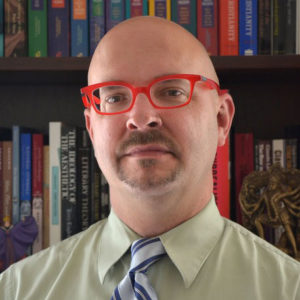
Over the Edge
Is there a pedagogical responsibility to traumatize our students?
I’m not thinking of some unbridled notion of “tough love” in grading, or an exaggerated insistence that actions have consequences, or even routine attempts to challenge assumptions and perspectives. Rather, is there a pedagogical responsibility to make students feel less safe, less secure, less stable, to insist that the world is more sinister, more dangerous, more potentially harmful than they might at first suspect or admit?
I grapple with this question in many of my courses. For example, I teach a course focused on cinematic representations of Jesus that strives to enable students to read such films rhetorically, in conversation with their own historical and cultural moment as well as the current one. To do this well, we have to tease out the ways in which the films support (and resist) anti-Semitism, nationalism, misogyny, racism, homophobia, erotophobia, and Christian imperialism. In a general education course that explores American histories of race, gender and sexuality through horror films, we grapple with very similar issues. Students resist ideological critiques of these films claiming that such analyses read too much into them or make too much out of minor details or simply exaggerate the importance of “mere entertainment.” Students also emphasize their historical distance from these films—racist and sexist imaginaries may have infected the forties, fifties, sixties, seventies . . . even the early aughts, but those problems have been resolved, and we occupy a more enlightened moment. Part of my work in these courses is to push back, gently but persistently, against these defenses and resistances and force an encounter with ugly, painful, dehumanizing energies. Part of my work is to help students see what they might be unwilling to see about the ways various cultural representations try to prevent them from seeing.
Questions about confronting students with potentially traumatizing material are often resolved by appealing to students’ identities. In a recent Facebook conversation, a group of colleagues discussed whether it would be appropriate to screen video of the white supremacist rally in Charlottesville in class. There was a concern about protecting students of color and a desire to confront white students. While these priorities made—and make—sense to me, they aren’t fully consonant with my experience as a teacher. I have had female students challenge claims that an argument or analysis is sexist, had queer-identified students champion fairly optimistic assessments of the presence of religious homophobia, and had students of color contest of racism in representations. By no means am I suggesting that my assessment of the cultural, political, and ethical dynamics of materials is always correct—and I certainly try to create classroom spaces where students can respectfully challenge interpretations offered by course materials, their classmates, and me—but it seems important to note that it may very well be those students who are most likely to be targeted by certain systems of unjust and injurious power—i.e., those students who we worry most about (re-)traumatizing—who may be least willing to acknowledge their vast reach.
These challenges were most pronounced in a course I co-taught a couple of years ago entitled “The Violence of Hope.” This course interrogated the ways in which discourses of progress, restoration, healing, and redemption—in politics, ethics, and religion—disguised, perpetuated, or intensified violence. The course pressed the notion that we are all inevitably and inextricably implicated in and complicit with systems of violence and that our attempts at amelioration are often mechanisms of acceleration. Many of our students had deep activist commitments. Most of our students confessed feelings of hopelessness and frustration as the course progressed. Ultimately, what I think made the course work—what I think makes my film courses work, my Queer Theory coursework, my courses focused on sexuality and religion work—is that there was an acknowledgment of the enormity and seriousness of the questions raised by the materials under consideration and a genuine, patient attempt to grapple with them.
In my teaching, I heed the call to traumatize my students. I work to make them more paranoid—or paranoid in new keys. But this is never the goal of my courses. By the same token, it is never my goal to solve the problems I raise, answer the questions I pose—or even offer palliative care for the injuries I may inflict. Instead, I seek to help students develop the skills, the habits, and the dexterity to negotiate the fraught, uncertain, and ever-shifting terrain that comprises their world. Consistent with my sense of responsibility, the only way to develop such capacities is to enter hostile territory.
Leave a Reply